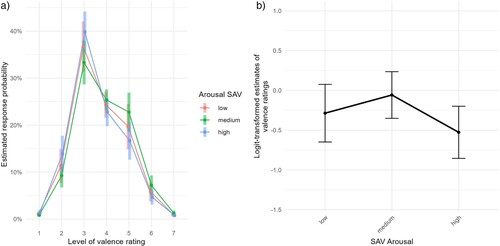Figures & data
Table 1. Synoptic view of all conducted experiments.
Table 2. Stimulus characteristics for pseudowords for manipulation of valence (Exp. 1a) and arousal (Exp. 1b).
Figure 1. Response patterns for valence ratings for Experiment 1a across different conditions. (a) Estimated response probabilities for each level of valence rating by valence SAV condition (negative, neutral, positive) given in percentages within 95% confidence intervals. (b) Model-based marginal means of post-hoc comparisons for each valence condition, illustrated with point estimates and error bars representing asymptotic confidence limits given on the logit (not the response) scale.

Figure 2. Response patterns for arousal ratings for Experiment 1b across different conditions. (a) Estimated response probabilities for each level of arousal rating by arousal SAV condition (low, medium, high) given in percentages within 95% confidence intervals. (b) Model-based marginal means of post-hoc comparisons for each arousal condition, illustrated with point estimates and error bars representing asymptotic confidence limits given on the logit (not the response) scale.

Table 3. Stimulus characteristics for pseudowords for manipulation of valence (Exp. 2a) and arousal (Exp. 2b).
Figure 3. Response patterns for valence ratings for Experiment 2a across different conditions. (a) Estimated response probabilities for each level of valence rating by valence SAV condition (negative, neutral, positive) given in percentages within 95% confidence intervals. (b) Model-based marginal means of post-hoc comparisons for each valence condition, illustrated with point estimates and error bars representing asymptotic confidence limits given on the logit (not the response) scale.
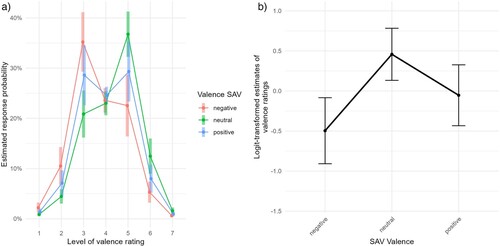
Figure 4. Response patterns for arousal ratings for Experiment 2b across different conditions. (a) Estimated response probabilities for each level of arousal rating by arousal SAV condition (low, medium, high) given in percentages within 95% confidence intervals. (b) Model-based marginal means of post-hoc comparisons for each arousal condition, illustrated with point estimates and error bars representing asymptotic confidence limits given on the logit (not the response) scale.
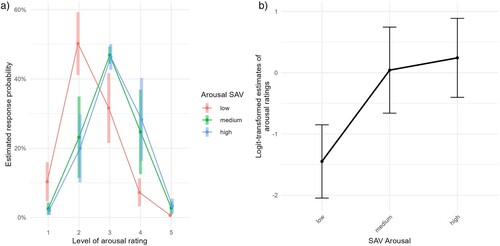
Table 4. Stimulus characteristics for pseudowords for manipulation of valence (Exp. 3/4a) and arousal (Exp. 3/4b).
Figure 5. Response patterns for valence ratings for Experiment 3a across different conditions. (a) Estimated response probabilities for each level of valence rating by valence SAV condition (negative, neutral, positive) given in percentages within 95% confidence intervals. (b) Model-based marginal means of post-hoc comparisons for each valence condition, illustrated with point estimates and error bars representing asymptotic confidence limits given on the logit (not the response) scale.
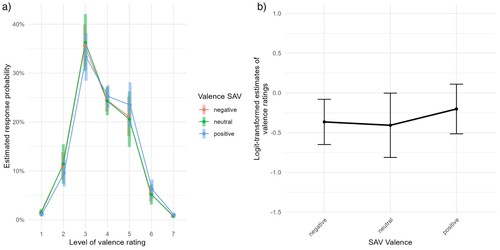
Figure 6. Response patterns for arousal ratings for Experiment 4a across different conditions. (a) Estimated response probabilities for each level of arousal rating by valence SAV condition (negative, neutral, positive) given in percentages within 95% confidence intervals. (b) Model-based marginal means of post-hoc comparisons for each valence condition, illustrated with point estimates and error bars representing asymptotic confidence limits given on the logit (not the response) scale.
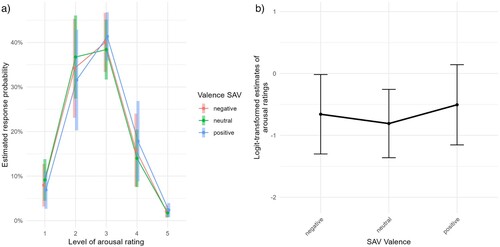
Figure 7. Response patterns for arousal ratings for Experiment 3b across different conditions. (a) Estimated response probabilities for each level of arousal rating by arousal SAV condition (low, medium, high) given in percentages within 95% confidence intervals. (b) Model-based marginal means of post-hoc comparisons for each arousal condition, illustrated with point estimates and error bars representing asymptotic confidence limits given on the logit (not the response) scale.
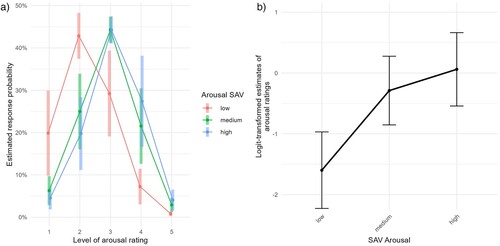
Figure 8. Response patterns for valence ratings for Experiment 4b across different conditions. (a) Estimated response probabilities for each level of valence rating by arousal SAV condition (low, medium, high) given in percentages within 95% confidence intervals. (b) Model-based marginal means of post-hoc comparisons for each arousal condition, illustrated with point estimates and error bars representing asymptotic confidence limits given on the logit (not the response) scale.
